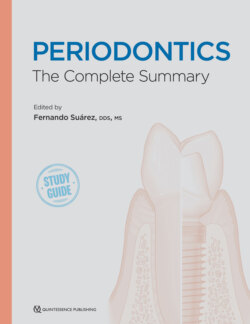Читать книгу Periodontics - Fernando Suarez - Страница 96
На сайте Литреса книга снята с продажи.
ROOT CONCAVITIES
ОглавлениеRoot concavities are common features of the root configuration and act as predisposing sites for periodontal breakdown.70 Additionally, the presence of these developmental depressions will impair mechanical instrumentation during nonsurgical and surgical therapy, especially for multirooted teeth.
Fox and Bosworth conducted a morphologic assessment to determine the presence of proximal concavities on extracted teeth among all tooth types.110 The authors concluded that nearly every tooth has concavities at or within 5 mm apical to its CEJ.110 For multirooted teeth specifically, Booker and Loughlin reported mesial concavity depths of 0.35 mm and 0.44 mm associated with single-rooted and two-rooted maxillary first premolars, respectively.74 Generally, these depressions tend to be deeper on the mesial aspects and middle third of the root surface.75 Conversely, Gher and Vernino reported a prevalence of 78% of concavities around maxillary premolars being not clinically relevant until 50% of interproximal bone loss had occurred.70
Bower also extensively explored the concavity depth and incidence around maxillary and mandibular first molars.111 Within the maxillary first molar, concavities are more likely found on mesiobuccal (94%) than distobuccal (31%) or palatal (17%) root surfaces. A higher incidence was also noted among mandibular first molars on both mesial (100%) and distal (99%) root surfaces (Table 5-7).74,111
TABLE 5-7 Prevalence and root concavity depth around maxillary and mandibular molars74,111
